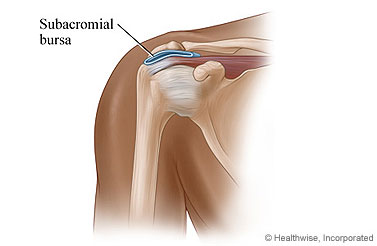
Overview
Bursitis is inflammation of the bursa. A bursa is a small sac of fluid that cushions a joint and helps it move easily. A bursa sits under the highest point of your shoulder. You can get bursitis by overusing your shoulder, which can happen with activities such as lifting, pitching a ball, or painting. Symptoms of bursitis include pain when you move your arm. Your arm may hurt when you try to lift it, and the pain can reach down the side of your arm. You may have trouble sleeping because of the pain.
Bursitis usually gets better if you avoid the activity that caused it. If pain lasts or gets worse despite home treatment, your doctor may draw fluid from the bursa through a needle. This may relieve your pain and help your doctor know if you have an infection. If so, your doctor will prescribe antibiotics. If you have inflammation only, you may get a corticosteroid shot to reduce swelling and pain. Sometimes surgery is needed to drain or remove the bursa.
Follow-up care is a key part of your treatment and safety. Be sure to make and go to all appointments, and call your doctor if you are having problems. It's also a good idea to know your test results and keep a list of the medicines you take.
How can you care for yourself at home?
- Put ice or a cold pack on your shoulder for 10 to 20 minutes at a time. Put a thin cloth between the ice and your skin.
- After 3 days of using ice, use heat on your shoulder. You can use a hot water bottle, a heating pad set on low, or a warm, moist towel. Some doctors suggest alternating between hot and cold.
- Rest your shoulder. Stop any activities that cause pain. Switch to activities that do not stress your shoulder.
- Take your medicines exactly as prescribed. Call your doctor if you think you are having a problem with your medicine.
- If your doctor recommends it, take anti-inflammatory medicines to reduce pain. These include ibuprofen (Advil, Motrin) and naproxen (Aleve). Read and follow all instructions on the label.
- To prevent stiffness, gently move the shoulder joint through its full range of motion. As the pain gets better, keep doing range-of-motion exercises. Ask your doctor for exercises that will make the muscles around the shoulder joint stronger. Do these as directed.
- You can slowly return to the activity that caused the pain, but do it with less effort until you can do it without pain or swelling. Be sure to warm up before and stretch after you do the activity.
When should you call for help?
Call your doctor now or seek immediate medical care if:
- You have a fever.
- You have increased swelling or redness in your shoulder.
- You cannot use your shoulder, or the pain in your shoulder gets worse.
Watch closely for changes in your health, and be sure to contact your doctor if:
- You have pain for 2 weeks or longer despite home treatment.
Where can you learn more?
Go to http://www.healthwise.net/patientEd
Enter M955 in the search box to learn more about "Shoulder Bursitis: Care Instructions".
Current as of: July 31, 2024
Author: Ignite Healthwise, LLC Staff
Clinical Review Board
All Healthwise education is reviewed by a team that includes physicians, nurses, advanced practitioners, registered dieticians, and other healthcare professionals.

